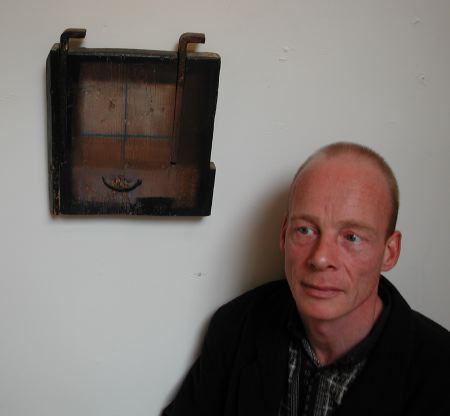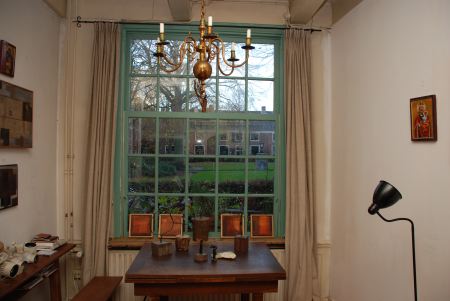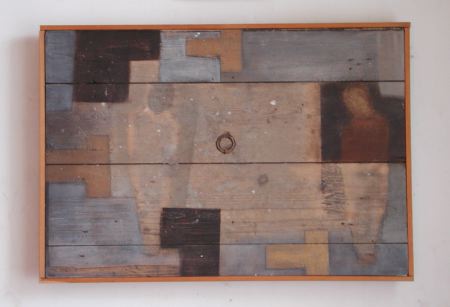
Painting
From Life vs.
From Photos

Jennifer Hoes at her self-wedding in Haarlem, The Netherlands, 2003.
KARL ZIPSER: Jennifer, why did you marry yourself?
JENNIFER HOES: I married myself at the moment I was prepared to embrace my own life and agree on the responsibilities that come with that. I married myself at the age my father died, I decided not to stay in the shade of his death at thirty.

Jennifer Hoes in her studio in Haarlem speaking, about porcelain objects cast from her body, with her mother.
KARL ZIPSER: Is it not a bit self-centered to marry yourself?
JENNIFER HOES: I believe if a person is loyal to him- or herself, he or she he has more to offer to others — to be active, straight and involved in relationships. Therefor, by no means, is marrying yourself a self-centered act. In my wedding I needed my family and friends there as my witnesses and it was also a celebration of my relationships and intentions with them.

Installation at a big plant and flower fair in Holland: Jennifer Hoes is “Eva” in a back-projected movie within the installation; her porcelain objects represent the animals in paradise.
KARL ZIPSER: Marriage is of course more than a ceremony. There is also a wedding night . . .
JENNIFER HOES: The wedding night I spent alone and slept like a baby! I feel my wedding-night was the most logical one after a hectic day!
KARL ZIPSER: There is also a honey moon . . .
JENNIFER HOES: Unfortunately I had no money for a honeymoon, that would have been nice and welcome after the hard work.

Jennifer Hoes’ porcelain vases based on cast of her thighs [photograph: Eric van Straaten]
KARL ZIPSER: Also there is the rest of your life “together.” How does self-marriage affect your life on a day to day basis? Do you find yourself a good life-partner so far?
JENNIFER HOES: My wedding ring says “I will return to my heart every time.” I read this every day. I think the values to an individual life are pretty much the same as in a marriage, it is about how you’ll behave, about taking responsibility, about being a loving person. The promises you make in the ceremony concern good intentions. The intention to do your best, be involved, be sincere, etc. and the ceremony is something you do for the moment later when you’re making a mistake in the relationship, to remind you of your promises and to make up for your mistake. To always try your best. Of course, I’m not always happy with myself and the things I do.
KARL ZIPSER: Does your self-marriage preclude you from a traditional marriage with another man or woman?
JENNIFER HOES: I can still marry a partner. But I do feel I had my moment in white, so I’m not eager to take the trip to the city-hall again.

A nipple montage by Jennifer Hoes
KARL ZIPSER: Would it be fair to say that your wedding was an “art event”?
JENNIFER HOES: I don’t claim my work (or wedding) is art. I do, and make, what I feel I have to do or to make. The “art” label is given by others. The media, because of the wedding, tried to own me, make me say or do things. I had to verbally fight with reporters and kept most of them out of my wedding ceremony. I did not invite them. The truth is I did not reject them altogether when they did come. I enjoyed the attention, but to an extent.

Jennifer Hoes beside a nipple montage
KARL ZIPSER: Jennifer, you indeed got a lot of media attention because of your self-marriage. You present your “wedding” as an important personal experience. Wasn’t it just a publicity stunt to promote your art?
JENNIFER HOES: Today people still ask me when the next big “stunt” will be. I am hurt when people degrade my very being to a stunt. The wedding cost me a lot of time, effort and money. Also, very important, I did not make any money out of it, would also not justify it being a stunt for the sole purpose of entertaining others.
Karl, I don’t make a distinction between my life and work. Therefore my wedding can be considered “work.” It also explains why I can so easily use my own body as a tool. I believe life is a matter of design — for the biggest part we are the designers of our own lives. I believe we have more influence on our own lives then we sometimes realize. It is about taking responsibility and accountability. I use this concept in my work. At the physical level the work is based, sometimes literally, on the from of my own body. But the work is also is a projection of my heart and mind. The wedding, as something of heart and mind, is just as relevant to my work as a cast of my nipples.

Jennifer Hoes in her “Summer dress made of silk and silver.”
KARL ZIPSER: Will you take questions from readers here on Art & Perception?
JENNIFER HOES: Yes.













